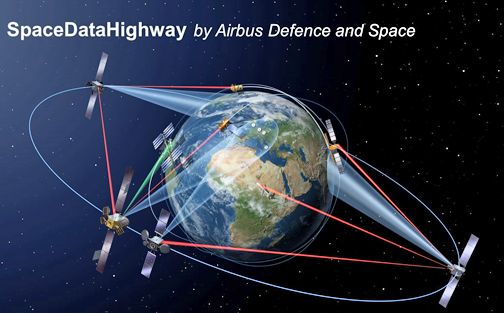
The third communication node of the SpaceDataHighway has been initiated by Airbus Defence and Space—this third node, EDRS-D, is to be positioned over the Asia-Pacific (APAC) region by 2020 and will be the next step toward global optical fiber in the sky.
EDRS-D will include several major innovations that will be developed in partnership with ESA. Following the ESA Ministerial Council in December 2016, critical activities dedicated to laser communication in space are being initiated. EDRS-D will be equipped with multiple laser communication terminals performing optical bi-directional links in order to simultaneously serve a number of satellites, drones and aircraft. EDRS-D will also be able to establish a laser communication link with another geostationary relay satellite of the SpaceDataHighway in order to relay data to the other side of the globe while being at the cutting-edge of security standards.

The SpaceDataHighway service will enable rapid near-real time tasking and high bandwidth data download to ensure the highest reactivity, lowest latency and high volume data transfer for Earth Observation (EO) satellite and airborne platforms. This represents a step change in the speed of space communications. Ultra-broadband laser communications and the geostationary orbit of the relay satellites combine to deliver a unique, secure, near real time data transfer service, making data latency a thing of the past. Thanks to laser technology, the SpaceDataHighway can transfer high-volume data from EO satellites and airborne platforms at a data rate of 1.8 Gbps and can transmit as much as 40 terabytes per day in quasi real time. The European Union’s Copernicus Sentinels are the first spacecraft to benefit from these next-generation services.
The SpaceDataHighway program is a result of a Public-Private Partnership (PPP) between ESA and Airbus Defence and Space. The German Space Administration DLR is also a key contributor. The innovative laser communication terminals (LCT) are developed and built by the German Airbus subsidiary Tesat Spacecom.
EDRS-A, the first relay satellite for the SpaceDataHighway program, was launched on January 29, 2016. Positioned at 9 degrees East, this first communication node offers coverage from the American East Coast to India. A second satellite will be launched in 2017, which will extend the coverage, capacity and redundancy of the system.

